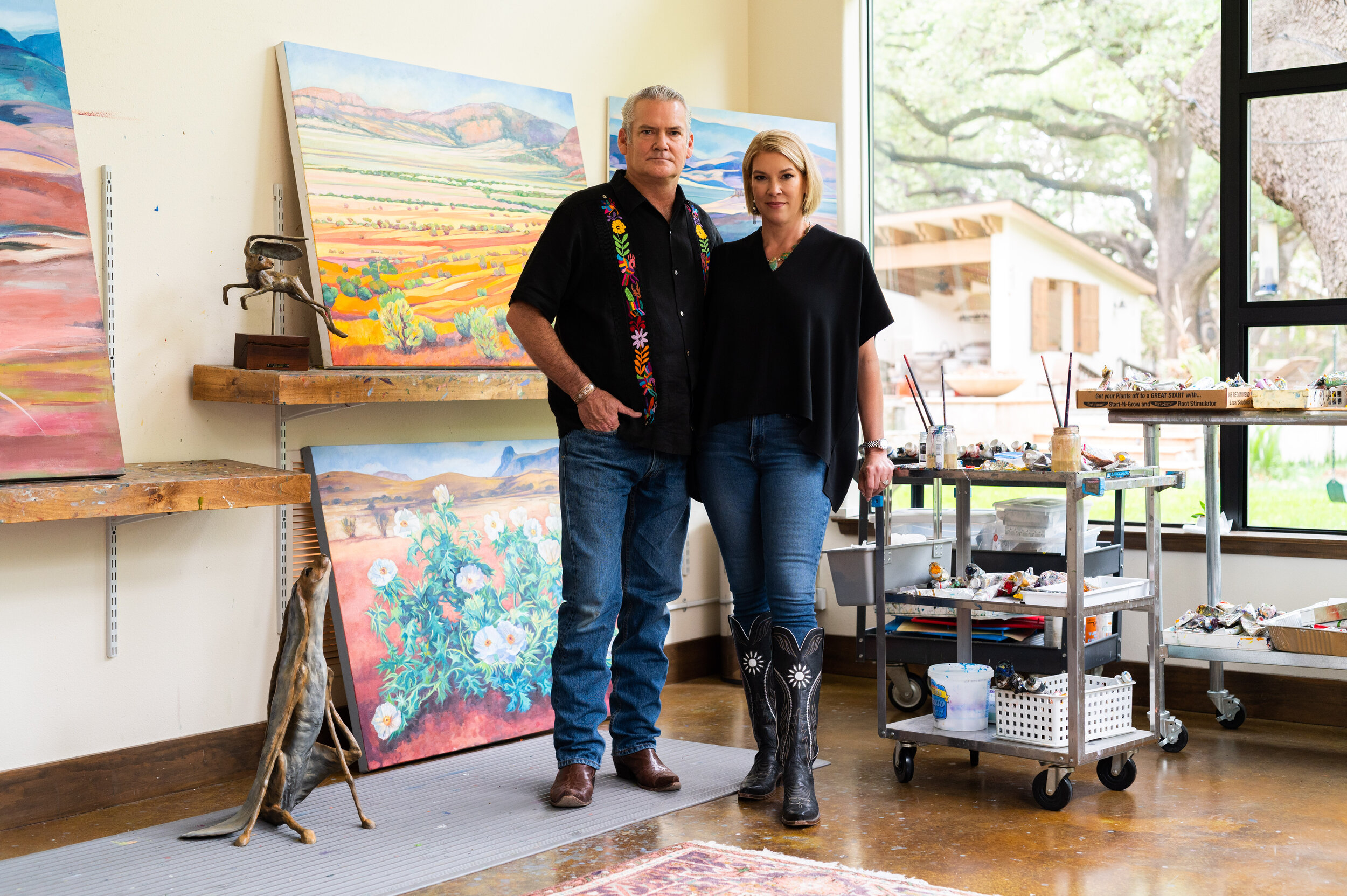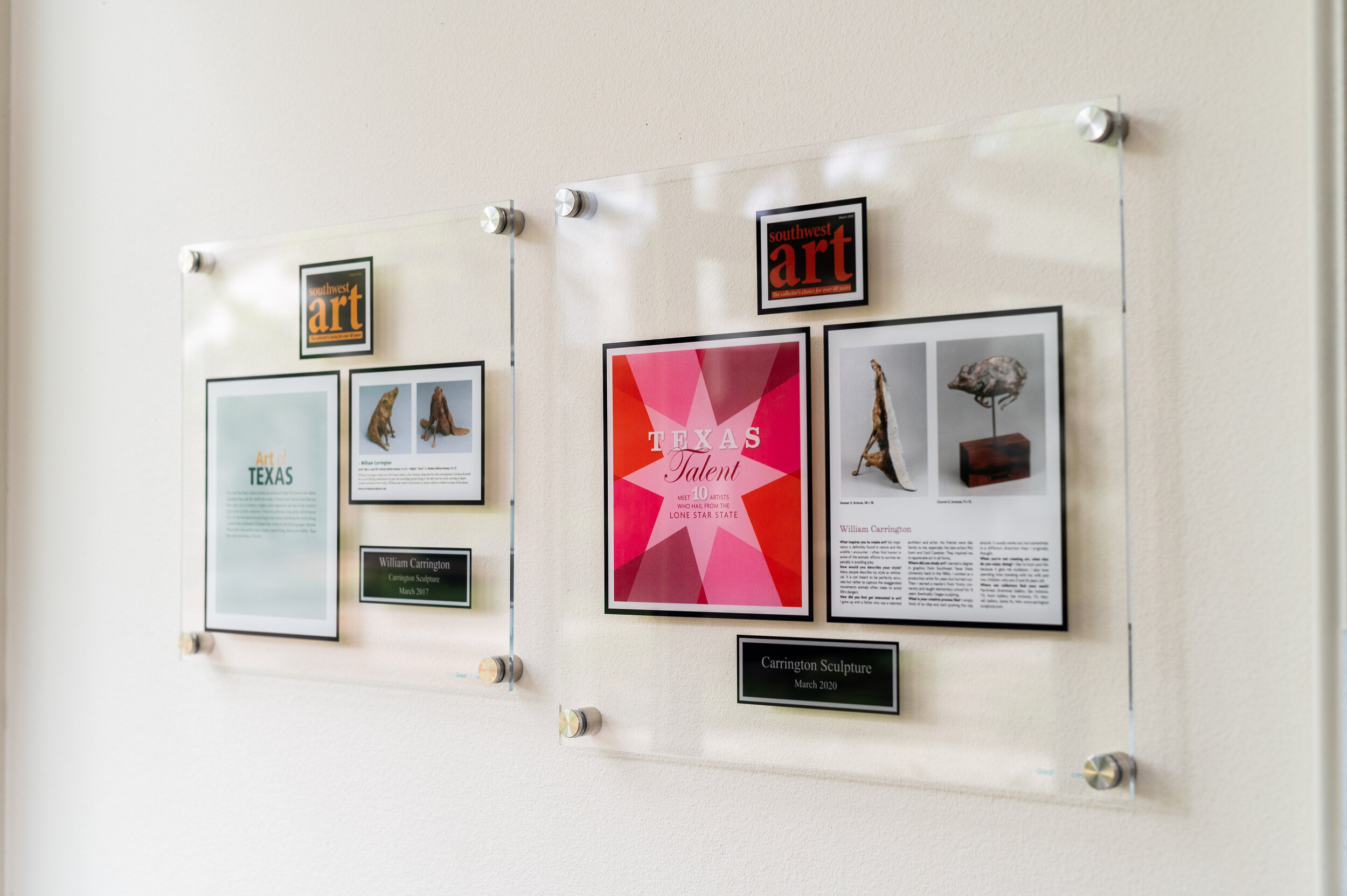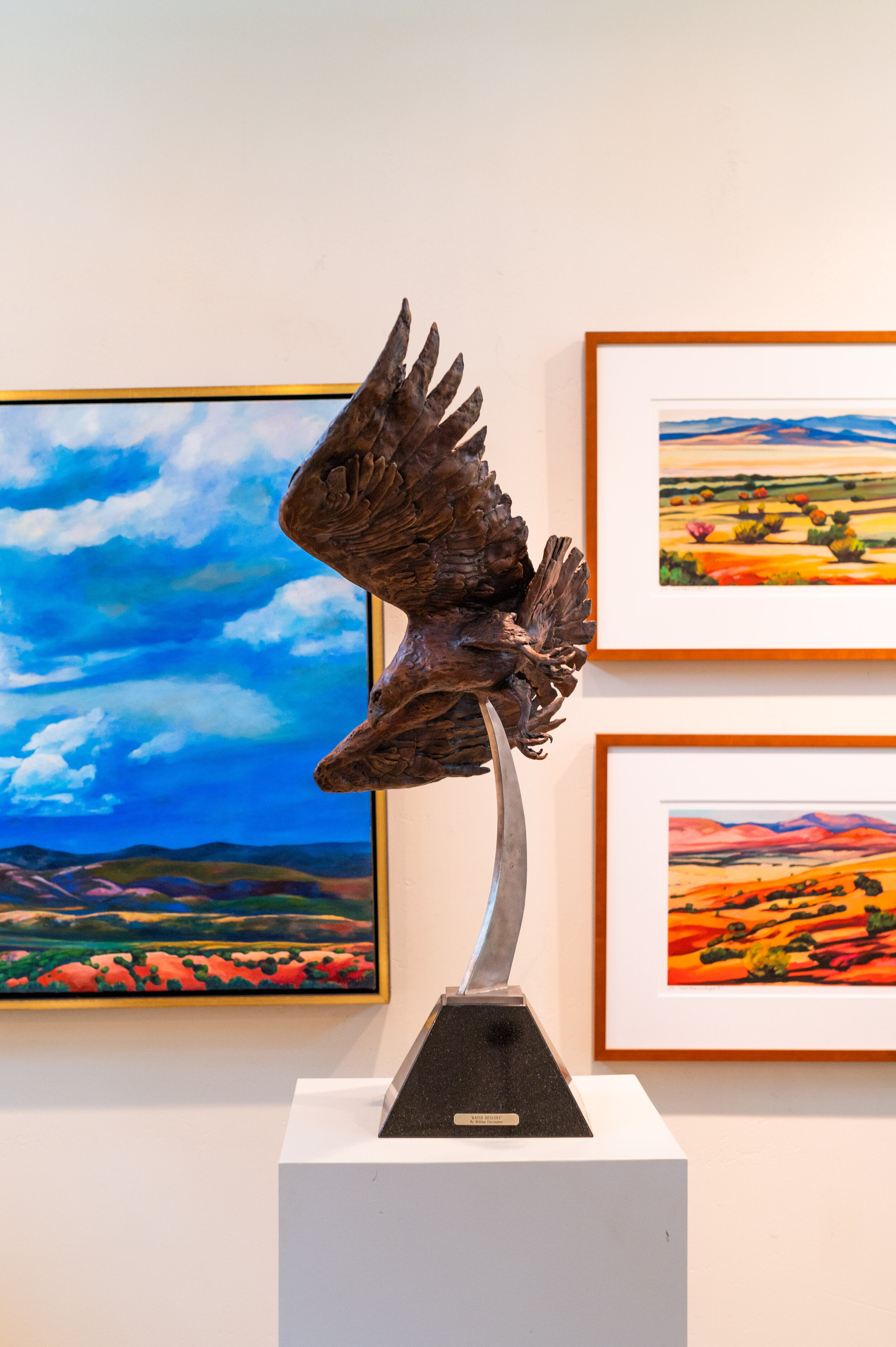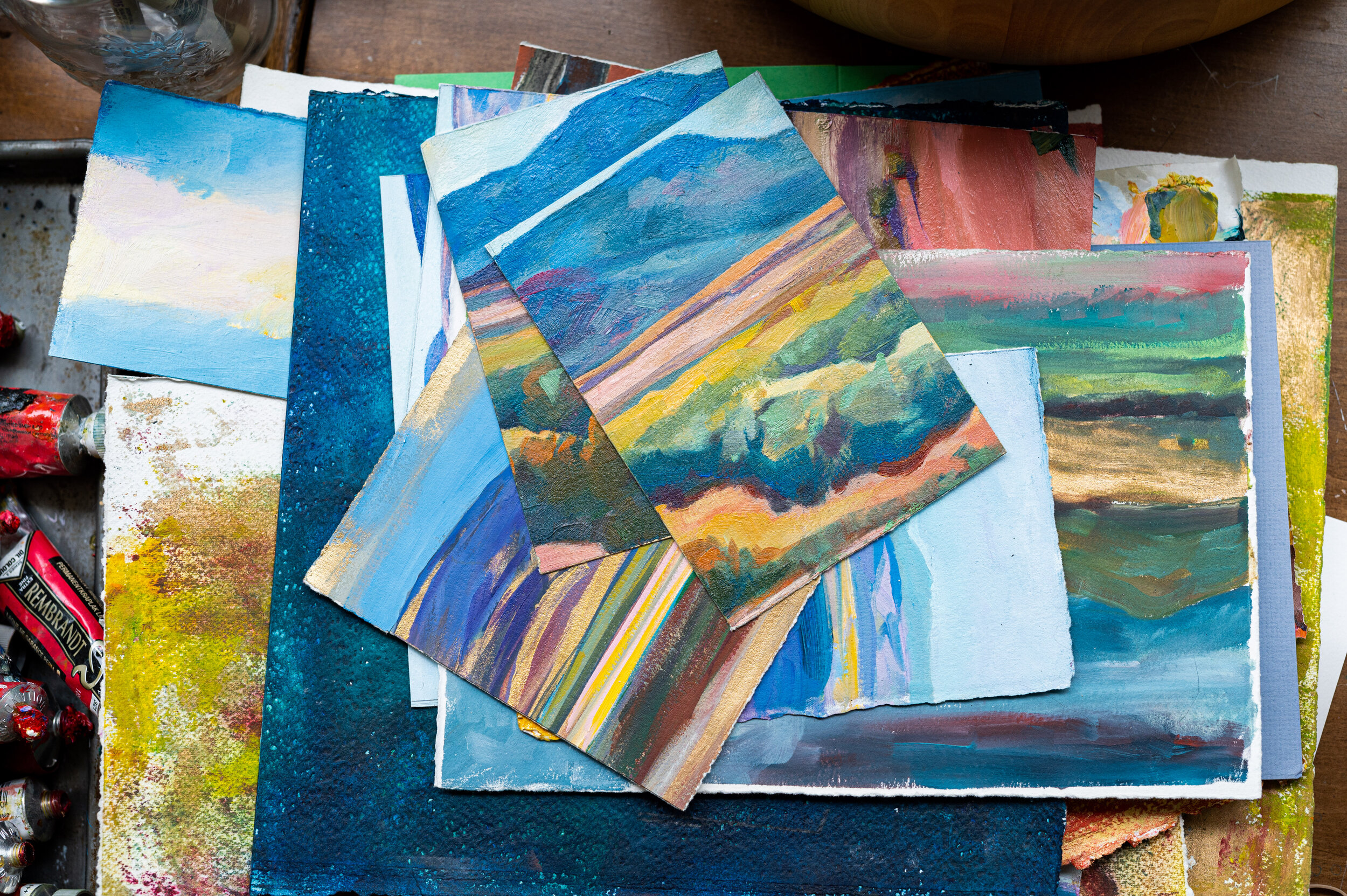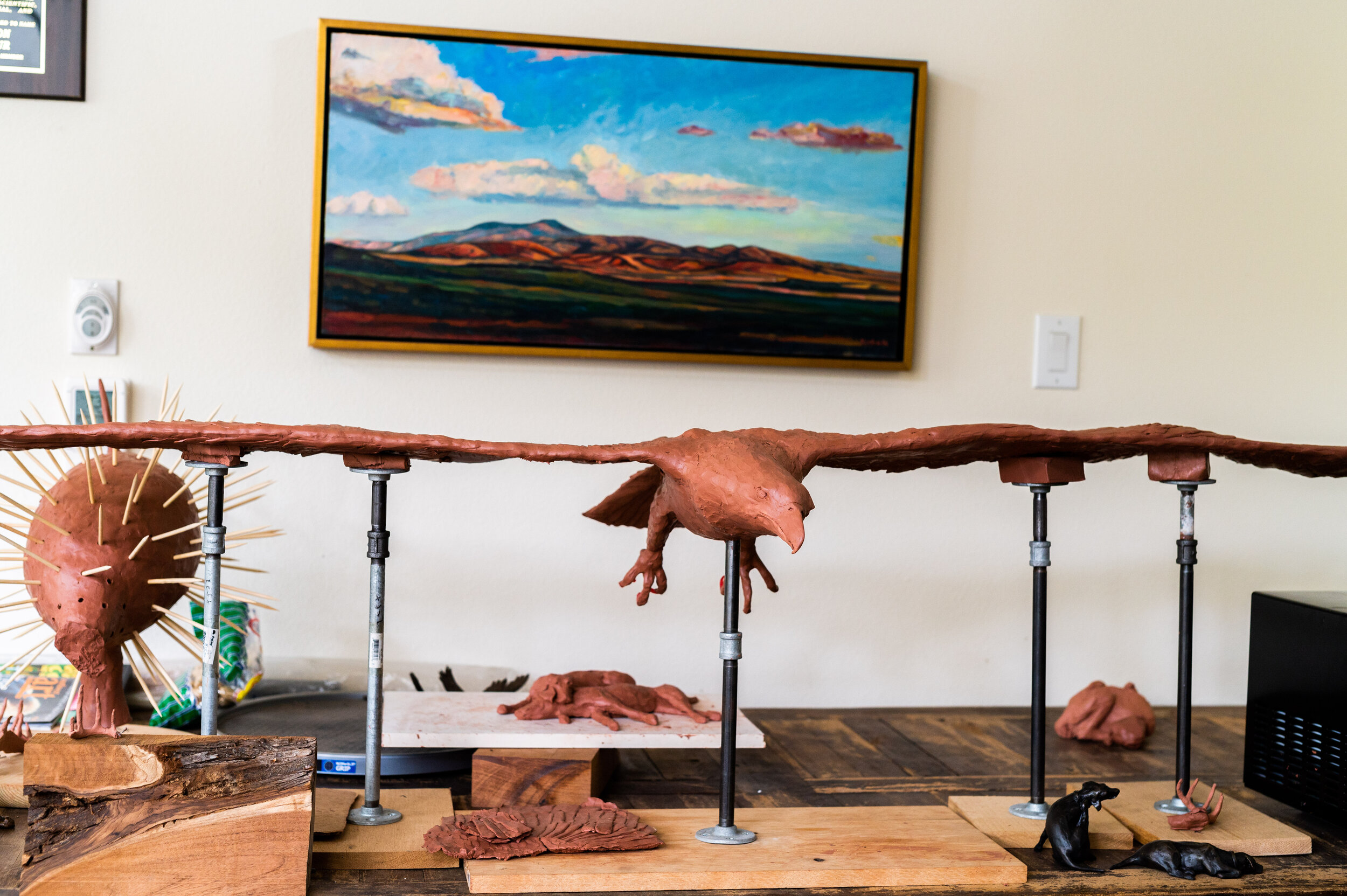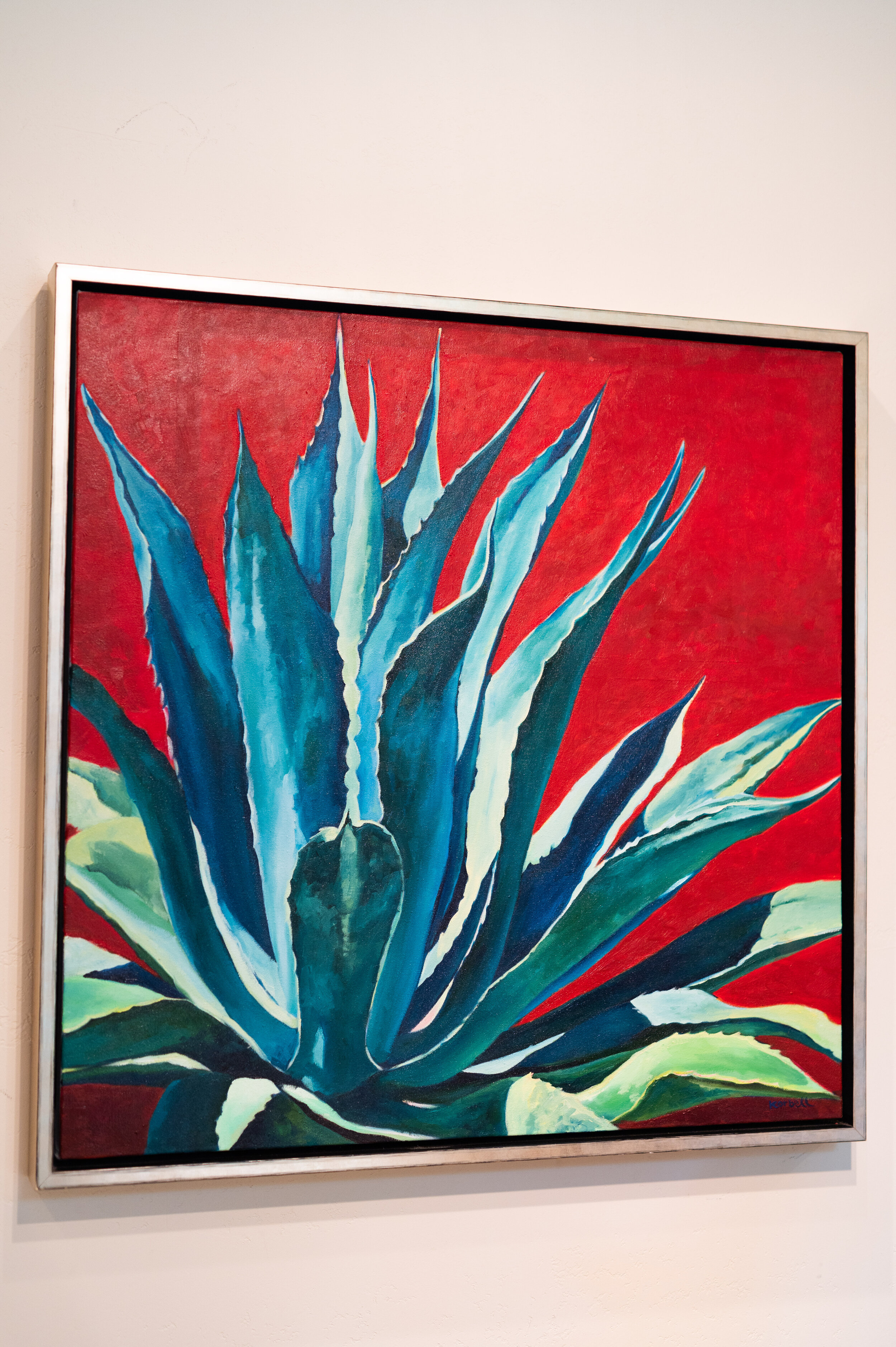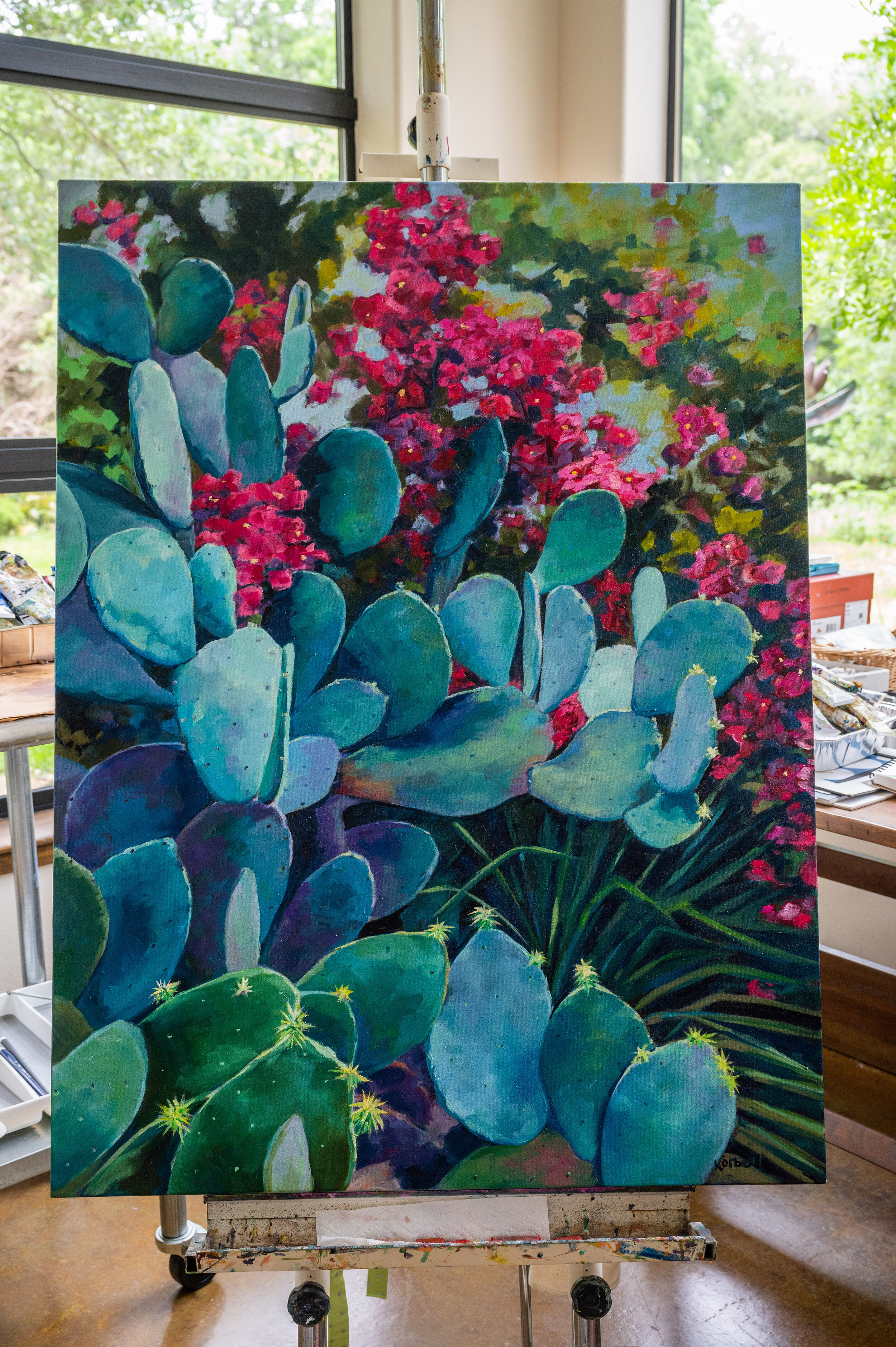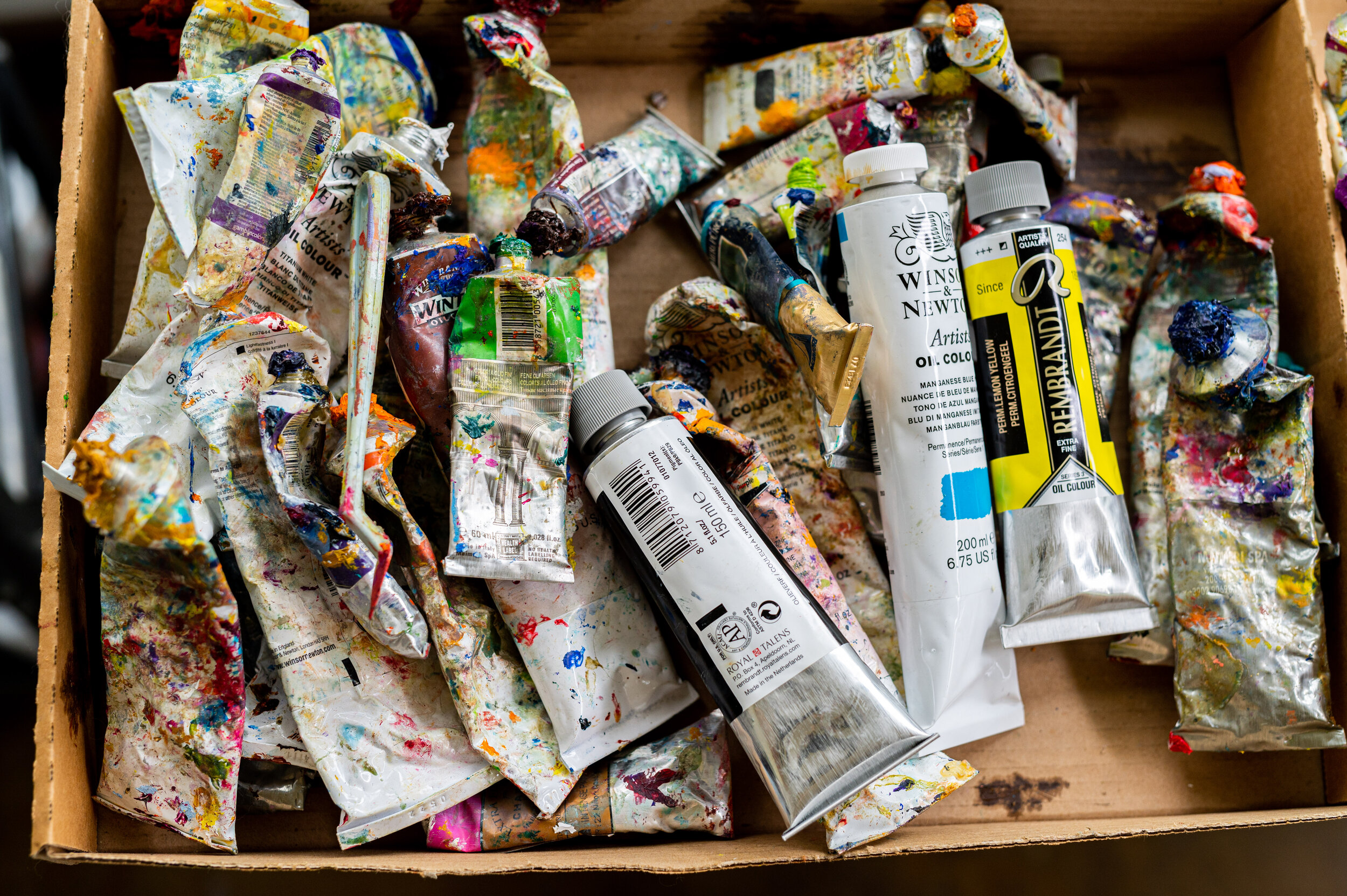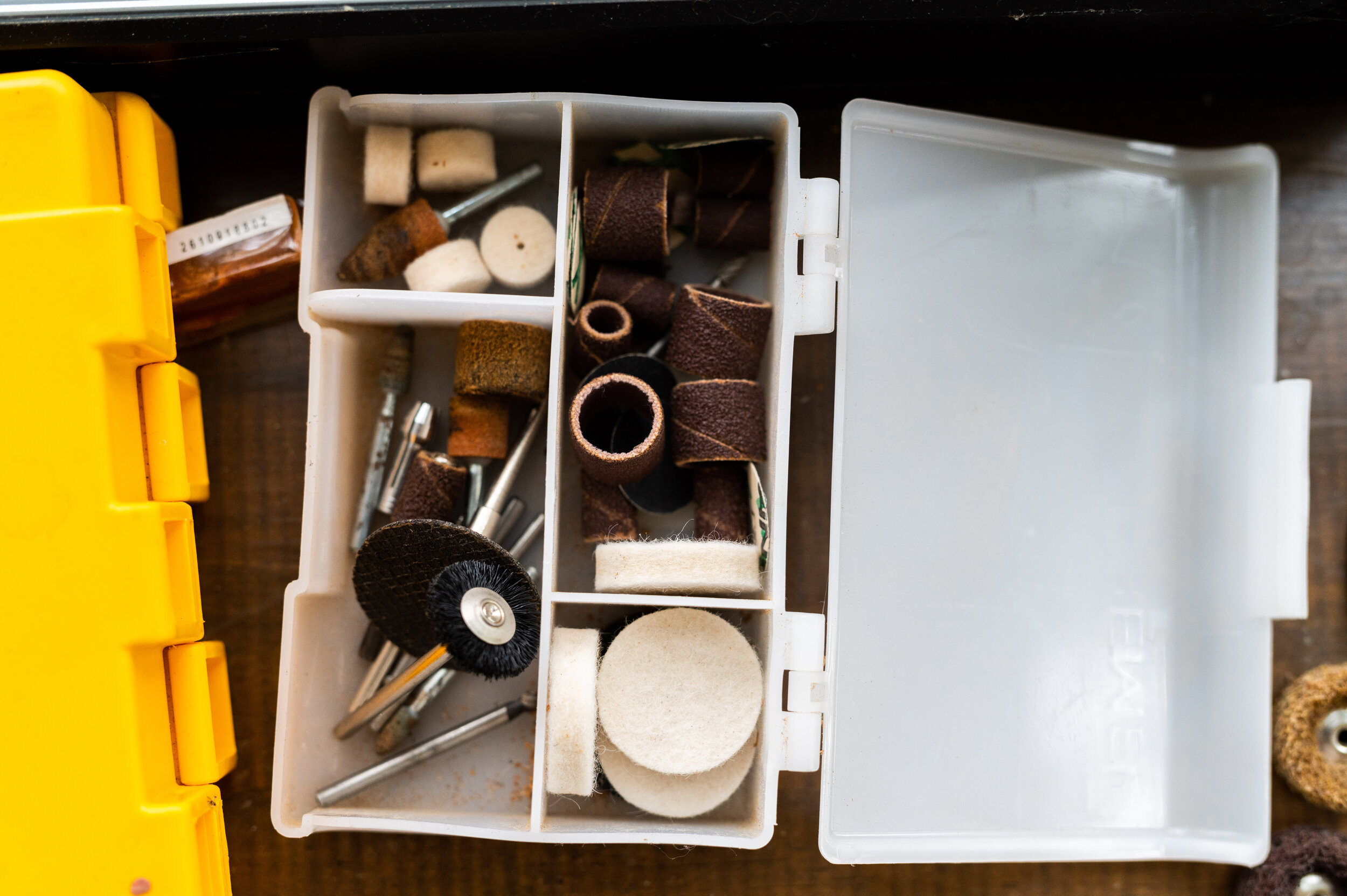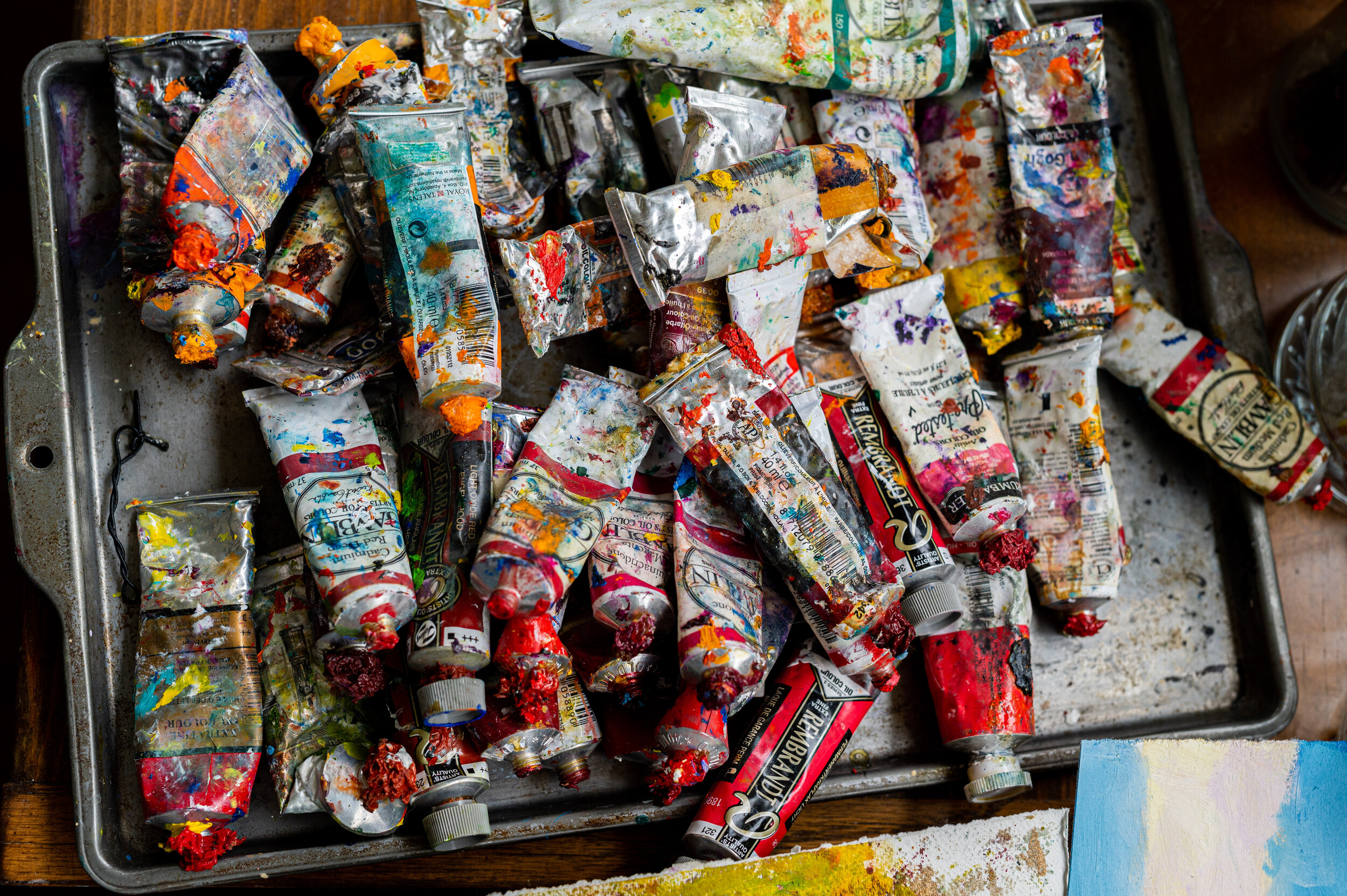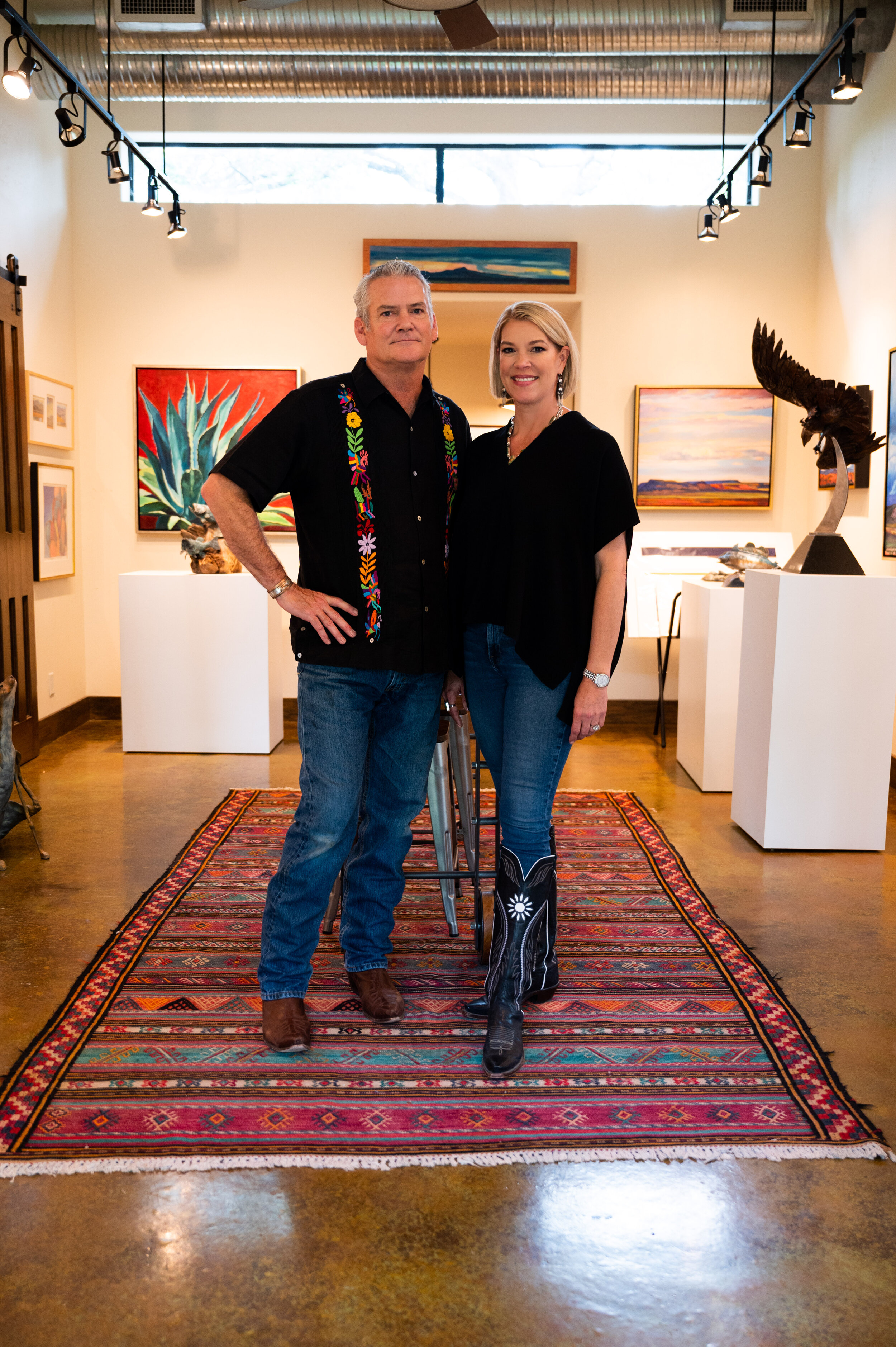BY WENDY BOWMAN BUTLER
June 14, 2021
A forest green wood-lined structure made of concrete and glass sits nestled in giant oak trees behind Caroline Korbell Carrington’s and William Carrington’s home. The building blends seamlessly into the surrounding foliage—a clear design of those who love and respect the land. I enter the space directly to their shared gallery. Everything is kinetic and alive. Dramatic bronze animals fly and sprint around to a backdrop of colorful, surrealist, sprawling southwestern landscapes. To the left is Caroline’s painting studio, softened with a large rug and a cozy lounge area surrounded by books. To the right is William’s sculpture studio, filled with industrial tools, clay, and game heads next to a wall of family photos, mementos, and awards. The floor-to-ceiling glass windows are the most stunning features in each space. They wrap around the corners of both studios flooding the rooms with light and greenery, blurring any division of the interior and exterior, and leaving the artists to work as one with the natural world.
Caroline and William are full of energy. William has many tales to tell and loves to crack jokes, constantly filling the workspace with sounds of booming laughter. Even his long-eared rabbit sculptures look up at us with giant smiles. Caroline welcomes us with warmth, wisdom and effervescence. Her paintings feel the same way—they have a depth and personality making the land feel like it is living, moving, and breathing. The two artists together ignite something very special and rare. They are in a flow state, working beside one another, balancing in unity with just enough space between them.
WENDY BOWMAN BUTLER: When and why did you all start making your work?
CAROLINE KORBELL CARRINGTON: I started when I graduated from college in 1992. I was a painting major and an education major. My first job was at a gallery to learn the business. I was painting landscapes. That was my go-to thing. I just loved it. I was really the only artist at TCU that did landscapes. I spent a lot of time in West Texas and the Hill Country and just painted a lot. I didn’t have my first show until ’92.
WILLIAM CARRINGTON: You were still in college I remember. You were about to graduate it was at…
WC & CKC: Los Patios
CKC: It was really really fun because it was the first time my family saw that I was really serious about making art. That’s where it began.
WC: And her claim to fame was that she had a painting stolen in a gallery at school.
CKC: I did and it was so exciting.
WC: And I’ve had a sculpture stolen.
WBB: That is exciting. It’s validating. [Laughs]
WC: I wonder who it was. I wonder where it is.
WC: I went to Southwest Texas State and got a graphics degree. They called it communications back then. Worked for a design firm here in San Antonio I think for about 8 years. Deadlines, stress, it just wasn’t my cup of tea. I was mainly the production guy—the computer guy. Back when computers were really big. Then I decided to become a school teacher. I went back to school at Trinity and got my masters and taught for 15 years. I started to get tired of that, like what do I do? What do I like doing? So I’ve always liked making things with my hands.
CKC: And you met me first. And I inspired you.
WBB: [Laughs]
WC: Yea we met in ’92, ’91. I quit teaching and called The Foundry and asked, “How do you make a sculpture?”, meaning bronze, and they said, “You’ve got to get this kind of clay” and you have to do this that and the other. So I made the first piece and took it to The Foundry and it was somewhat successful. It’s in there but it was hard to do because I didn’t do it correctly.
WBB: What was it?
WC: It’s a hawk. A life-sized hawk. So for the armature I had pencils in there and all sorts of stuff. You’re supposed to use little wires and so they weren’t real happy with me.
WBB: [Laughs]
WC: So that was 2011. So here I am and it’s 2021 so it’s going well.
WBB: That’s pretty incredible too just that amount of time.
WC: I never had a sculpture class in my life.
WBB: It’s raw talent is what I mean by that. It’s definitely one of those things where you’re like this was gifted to me from somewhere else.
CKC: Yes!
WC: When I started I was like darn I should have started this when I got out of college.
WBB: But don’t you think maybe those years where you were in the real corporate work place, suffering through that, you also learned a few things?
WC: Oh yeah definitely.
WBB: Not only about yourself but just the value of work.
WC: And business. I remember when I started with the design firm I had to ask what an invoice was because in art school they don’t teach you anything about business.
“Everything is trial and error in the art world.”
WBB: I find that people actually value paintings more than photography prints because there’s something about not being able to reproduce it. It’s this one original piece that you can’t recreate.
WC: Yeah that’s where we’re different because she makes a painting and it’s just one. When I do a sculpture I can do an edition. I usually do 20.
WBB: But they’re still handmade.
WC: They’re a little different. Yeah people don’t realize when you buy sculptures and it’s an edition 1 of 20 or 2 of 20 they think they’re all [the same]. A lot of people think the first one is the best one. It’s actually not. 20 of 20 is usually going to be your best one because by then you’ve got it down as far as the patinas go. That’s kind of a trial and error thing when you get started on a piece.
CKC: Everything is trial and error in the art world. If you go to art school or you don’t. Just being a painting major, no one taught me color theory. I learned that on my own. McLean did take a color theory class at SCAD but I never did that and I feel like my specialty is color. Maybe it is because no one taught me and I had to learn on my own that I really did a lot of investing in color.
“I’m a big hunter/ fisherman so my whole life I’ve viewed game and watched it and understand their behaviors...”
WBB: What role does the sense of location and place play in both of your work?
WC: That’s a good question.
CKC: That is a really good question.
WC: Outdoors obviously. Wildlife, outdoors, West Texas is really intriguing to me. That’s where the rabbit ideas came about. Because, well now there’s not because of the drought, but usually there are a ton of rabbits out there. Anything outside. I’m a big hunter/ fisherman so my whole life I’ve viewed game and watched it and understand their behaviors and things. So far as place, being in the middle of Texas is awesome. You can go to the coast in 2 1/2 hours. You’ve got West Texas, you’ve got piney woods, desert. So it’s a great place to be because you’ve got so much variety.
CKC: And also our family backgrounds. Both of us have ranching families. So for Thanksgiving, for Christmas, for special occasions, we always met up in the country somewhere. I always think that it’s our happy place and we were just very fortunate to find each other because we both value that. Our favorite places to go are out of town and the ranch. We drive around for hours and stop and take pictures. We spend hours taking pictures of landscapes.
WC: So fun for me because a lot of the paintings, especially the landscapes, I remember. I’m like Oh yeah I remember we were right there. One time I was in West Texas and these big storms were brewing and I grabbed your camera. You were busy doing something and I ran out and started taking pictures of all these beautiful storms and I think you had some successful paintings from them.
WBB: That’s so cool you’re capturing these moments in your life.
CKC: When I started off being a landscape painter, everything I did was plein air. That’s kind of what you did when you were a landscape painter. You would go with your little easel and your canvases and go outside. It was always very challenging because you’re getting blinded by the sun. I remember painting all of my canvases gray. Someone told me that and I thought it was brilliant because I didn’t get blinded by the white.
WBB: That’s such a smart idea.
WC: The plein air paintings are funny because every now and then there will be a bug stuck in it.
CKC: Oh there are bugs everywhere and you’re attracting the bees.
WC: The bees love the color.
CKC: The oil paint doesn’t dry for forever so usually they would eventually fly off. I had to rush. Everything was really really quick painting because you would lose your shadow or lose the light pretty quickly. It was great—I would do 12 paintings in like an hour or two because I had to. But I have to say over the years I’ve become more of a studio painter now. As far as location, I want to go out and experience the landscapes and maybe photograph a memory, but I prefer now to bring it back here because that’s how I make it my own and that’s how I developed my style. When you’re plein air painting, you’re so busy capturing the reality of what you’re seeing and getting the correct colors for the green and the sky. That’s how people are trained, but I never could develop my own style doing that. When I started coming to the studio, I started seeing and developing control of my own creation. Being able to make the colors that I choose, even though I’m gaining inspiration from reality, I’m changing it to what I want. So it was more enjoyable for me.
“I am super attracted to the dramatic. I’ve always wanted the vista—the full view captured in the whole landscape...”
WBB: I see it in both of your work—you’re blending the outside world and bringing it back in your studio, but also you blend traditional techniques with surrealism, so I wanted to know about how both of you do that with your work and why you do it?
WC: Mine is not traditional in the sense that the way I make things, I exaggerate them.
WBB: Right exactly, that’s what I’m saying—you’re using a traditional material…
WC: Oh yeah I’m using lost-wax process and it’s over 2,000 years old.
WBB: …And then your subjects are traditional subjects: landscapes and animals, but they don’t look like anybody else’s work. To me, I see this rabbit for instance and these paintings as a type of surrealism.
CKC: I am super attracted to the dramatic. I’ve always wanted the vista—the full view captured in the whole landscape with the foreground, middle ground, background situation. And then over time, slowly as I get older, I’m starting to pull back and focus more on a tree or a cactus or a little detail. I’ve never really been interested in doing that but now I am, and it’s just as dramatic as the whole landscape. I’ve always wanted to tackle more is more but then really less is more. You learn that as you get older a lot of the time. Some people get that when they’re young, but it took me a long time to figure that out.
WC: I’ve noticed throughout your career, you experiment. You’ve done collages, you paint tiles around here. You’ve done all sorts of things.
CKC: It’s fun. We both learned not to take ourselves too seriously. I think it’s really difficult to be a landscape painter because people know what you are doing. They have expectations of what it’s supposed to look like. Like oh, there’s a southwest painting. And they’re like why isn’t it realistic? It has my personality in it. Why do something in realism if that’s not what I want to do? Realism is beautiful and I love it, but I like to take that and make it mine, with my interpretation.
WC: I think your paintings take people places and that’s why they like them.
CKC: Everything I paint are places that I’ve been to and that I love. I’ve traveled to Italy, Hawaii, and we’ve been on these vacations, but I don’t really care about painting those places. I love those places, but I just love the southwest and the rugged beauty of the southwest.
WBB: And so William, when you’re dramatizing the animals what is the purpose behind that?
WC: The elongated ears and things like that kind of started by accident. I was just playing around one day and stuck a long ear on some rabbits and was like that actually looks kind of fun and it gave it a sense of speed. By doing the things I’m doing, it gives motion to something that doesn’t have motion. And humor. I always talk about the coyote and road runner—that’s kind of what it’s like. Everything is trying to kill the poor rabbits so I try to show some fear in their faces. They’re usually trying to escape and if they’re not, the poor little guys are itching or doing something. A lot of my stuff is moving at a rapid pace.
CKC: And I kind of do the same thing with my landscapes too. For instance, we’ve been in a drought. In Texas we’re in a drought a lot of the time so I use warm colors—lots of yellows and oranges because there’s no rain, but I make it pleasant and happy, not depressing. It’s still beautiful it’s just not what everybody wants—the green.
WC: It is beautiful but when you’re there looking at it in person sometimes it’s kind of sad because you see the signs of drought—bones and things like that and you’re like oof—tough.
CKC: And then we get the flood.
WC: Yeah exactly—from one extreme to the other.
WBB: Can y’all tell me about your individual processes?
WC: A lot of people think that I do sketches of what I’m going to do. I don’t. I just dive into it. Sometimes I’ll start on something and it becomes something else, which are usually my better pieces because I’m seeing something I didn’t and then it becomes what it is. It’s kind of fun. I just dive right in.
CKC: I do too. It’s really crazy.
WBB: Do you do under paintings?
CKC: I do but it drives people crazy. Most of my friends sketch and make sure it’s perfect and I make tons of mistakes because I just go directly onto the canvas. Sometimes I use charcoal and I can wipe it off real quick just to get the basic composition down but I don’t do any details. I just start painting and you just pray that it works out and if it doesn’t you just stick it aside and paint over it later. I’m a very impatient artist. I like to dive into it, too.
WC: We do utilize the internet. You know like road runners. Most people don’t know that road runners have four toes—two in front and two in back. I didn’t even know that until I started making one I said I better check on road runner’s feet.
WBB: Right because it’s not something you come across all the time like a rabbit on a ranch. You see a road runner every now and then.
WC: I could probably make any animal I see out of my memory but the details sometimes you’ve got to look at. When I did javelinas—the nose, and where the eye is in relation to the ear, and stuff like that.
CKC: We’re not perfectionists. A lot of artists are. If you even look at the way I have my palette, I have friends who come over and they’re like, “Is that what you’re using right now?” And I’m like, “yes”. A lot of people do the warm colors together and the cool colors together. I start off that way and then it’s just like forget it.
WC: If we were separated I would just come over and mess up all of her paints and she wouldn’t know where anything is.
CKC: [Laughs] It’s kind of an organized chaos.
“We compliment each other.”
WBB: Y’all are the first artist couple who I’ve covered. What’s it like to share your studio together? What are the enhancements and also what are the struggles you guys have faced individually but then also as a couple?
WC: My biggest struggle is just getting in the studio. I get sidetracked. I find things that I need to do and next thing you know my whole day is doing something else. That’s one of my biggest challenges definitely. And discipline. She has a lot better discipline. She eats dinner then she’s out here. I’m like no way, my day is over.
CKC: Everyone has their own time. When we were younger he would be at school teaching all day and I would be in here and we would kind of be jealous of each other. He would be able to see other people and I’m by myself. I would want to visit with him and be with him and he’d be like, “No, I was with kids all day, talking to parents. I just want to be on my own right now.” So we kind of had different lives and he’s like, “Well I really want to do what you’re doing.” While I would say, “I like the social aspect of what you’re doing.” Then when he decided he really wanted to be an artist and quit teaching, I missed the teaching a little bit because I liked the privacy, but now we can’t see it any other way than the way it is. We were very fortunate to build this studio as a his and hers.
WC: It’s easy because her studio is right here and mine is across a gallery that we built on the other side so we’re not on top of each other.
CKC: I think if I were to get a studio at Blue Star, or far away, I would make it into more of an office situation, but I am a person of convenience and I don’t like to do that. It’s like the gym—I know the gym may just be a block away, but if I have a place here, I am more likely to work out.
WBB: And this is the dream scenario—to build your own studio.
CKC: It really is. When he sees me out here working, then he comes in and works. We don’t put pressure on each other.
WC: No, she could put pressure on me, but she doesn’t.
CKC: We’ve been married for 26 years. When we were newly married, everything kind of bothered us. Now nothing bothers us. It’s like whatever, you can go work when you want to.
WC: I work in spurts too. Suddenly I’ll go in and within a short period of time, knock out 4-5 pieces, which I need to do right now. Then I’ll go through a dry spell.
CKC: Also, now it’s like, why have a single show? We have shows together. It used to just be me having a show but we have the same friends and the same clients so we have shows together. That puts a little more pressure on us too. If he says “I’m having a show,” then I think oh well I need to start painting.
WC: We compliment each other. If we were both painters having a show together, that would be a little tough.
CKC: He painted quite a bit when he was younger—you were really good at it.
WC: I have a problem with color. If I could get color down I might be better.
CKC: It’s funny because we see each other crossing ways and I’m like “You know what you need to do? You need to do this kind of sculpture. Or maybe you need to start making jewelry.” I always want to have him do stuff for me. Then he’s like “You need to paint this” and I’m like “Ok I’ll leave you alone. You do what you’re supposed to do.” [Laughs].
WC: She’s been working for years trying to get me to do animals standing on top of one another. Maybe one day.
WBB: So it seems like it’s more of an enhancement overall.
CKC: Definitely. We’re very very lucky. There’s a lot of creative people that live together. I’m sure your husband is creative because he recognizes that in you. If you marry somebody who is creative, you have to be a little creative too.
WC: So if you marry somebody who’s crazy you have to be crazy too. [Laughs]
CKC: You do have to be a little crazy. We definitely compliment each other.
WC: We work fine. We have people all the time say, “Oh my gosh, there’s no way I could be around my wife as much as you are.” I’m like, “What’s the big deal?” I don’t have a problem with it at all. It’s funny how in marriages, some people just can’t be together that much. I’ve never understood that.
“...what’s really cool about the San Antonio art scene is that all of the artists get along.”
WBB: Where do you guys see the Texas and maybe even Southwest art scenes going in the future?
WC: We just finished the Night of the Artists show at the Briscoe Museum. That is western art. It’s the cowboys on the horses and the ropes and the cows. That’s the traditional western art. I hate to say it, that’s not my thing, it’s beautiful though, but I hate to say it—it’s dying. The cowboy life in general is dying. Land is being chopped up. Cowboys aren’t really cowboys. Out in West Texas they used to have cowboys come from Sul Ross who were college students to work cattle and you can’t find them anymore.
CKC: The old school way of rounding up cattle is—old school. Only a couple of ranches still do it because it’s very dangerous and it’s a liability.
WC: Or the way they actually work cattle—like roping and throwing them. Now everybody’s using chutes and it makes sense—it’s the path of least resistance.
CKC: I think people are obsessed with the west and will always be obsessed with the west. I think that even though I don’t want to paint Indians and teepees, and I don’t want to do the cowboy thing, I am so thankful that other people do because it tells the history of the west. But I like to be included in that genre because I’m the west too. I want there to be more landscape painters. There are not enough people who want to do nature. There are a lot of people who do figurative or buildings or abstract.
WC: The San Antonio art scene is phenomenal.
CKC: I agree with that.
WC: And what’s really cool about the San Antonio art scene is that all of the artists get along. We’re friends with tons of artists who are really well established, big-time artists and they’re very supportive of us. I remember the first time I was in the Briscoe I was terrified because I felt like a rookie in the NFL going into my first game with the big boys. And everybody was so accepting and my work is not like the cowboys and the Indians and the roping. I was worried about that, but it didn’t seem to phase anybody.
CKC: I feel like San Antonio is very open. I think people here are very comfortable and we want people to have our art. We don’t feel like it’s an ego thing. Of course we would like to make money but I think everybody wants to be supportive of one another. They’re not judging you like, “Where did you go to school?”
WC: We got to visit with Chuck Ramirez the night before he passed away. I remember Chuck and I were out on a little balcony, it was at Patricia Ruiz at an art opening. A guy from Florida came up and started talking to Chuck and I and asked about the San Antonio art scene. Chuck rattled off everything I just said about how we all get along and it’s so cool. I’d known him since probably the early 90’s and I was sitting in a deer blind the next day—my phone rang—and he’s gone. I was like whoa. I don’t know if you were here but they had a huge memorial at Blue Star. Thousands of people. Tommy Lee Jones was there because he has some of Chuck’s work. It was massive.
CKC: We’ve had some really bad luck in the last couple of years with some really well known local artists who have passed. Brad Braune passed away. There are a lot of people but we are all very supportive of one another. I just hope that the younger generation are also wanting to get out there and meet everybody and learn about the art scene. I do feel sometimes as an older artist that there is a new wave of young people who have come that I don’t even know.
WC: Blue Star and Art Pace have the young people vibe.
CKC: Which is great.
WC: Which is great and I’m happy that Blue Star has the First Fridays because that gets people who aren’t artists to come down and be a part of it.
CKC: We have the Southwest School of Art now that’s accredited.
CKC: It’s incredible.
WC: And some really good Western art is at the Witte. Great Western Art.
WBB: I think it’s a reflection of the city too and how the culture is in our city, that we are supportive of one another and we are a tight knit community. I noticed even just being born and raised here—maybe I left for a while, but when I came back and I got introduced to a lot of new artists that are my age or your age or between our ages. Even just through doing this project I’ve not yet done a feature on an artist outside of San Antonio. A lot of that is just because COVID last year kept me here, but also there are so many people here and everybody is referencing each other even within my In The Studio pieces.
WC: Yeah like we know Vincent Valdez. We’re not super close but when we see him, we say hi and we visit. Vincent worked under an artist doing murals—Alex Rubio—he was doing murals somewhere and he said this little boy kept watching him and it was Vincent at 12 years old. Vincent would come every day to watch him paint murals and Vincent started helping him a little bit and next thing you know Rubio said, “You know what? I’m gonna go eat lunch. You just keep going.” That’s how talented he was. Vincent Valdez was in San Antonio for a long time, I think he’s in Houston now. His paintings are very cultural. We have one of his prints it’s called Pride Of The Southside and the sun is the hubcap and it really captures San Antonio with Whataburger sign in the background and it’s his brother in a boxing stance because his brother was a boxer, with his crooked nose.
CKC: Another thing about San Antonio that I love, and I think Texas in general, is that the business community is really involved with the artists and really want to help. The restaurant businesses like Cappy Lawton. There are a lot of people who help the hospitals get art. They want art to be a part of the corporate landscape.
WC: I just did a bronze piece that is in the Oxbow building across from the Pearl. There are like 9 artists that have different things in there. Diana Kersey is probably the focus. It’s really cool to get things like that and it’s a bank building so you know all of these banker type people will see it and hopefully will get them to appreciate art.
WBB: It seems like San Antonio has been doing this local sourcing since I was a kid. Even if you think about the structure of H-E-B. It was doing local Texas foods before local-organic was a thing.
WC: Even Frost Bank. Tom Frost was the neatest man. You could call his office any day of the week and he would answer the phone. Tom Frost, Frost Bank—he would answer the phone, not a secretary. That’s the kind of San Antonio feel. Herb Kelleher was the same way.
WBB: I hope that those types of things remain the same—a big city feeling like a tiny city—the biggest local city, you know what I mean?
CKC: Yeah.
WBB: I’m excited for people to come in from out of state and enjoy things but I want people to also embrace the Texas culture. So I wonder about that change in the art scene when I initially asked the question—when people come in and as the city and the state changes, as the country shifts and people move from city to city, and rural to urban, and landscapes shift…
WC: I think it will be really interesting to see where San Antonio is in 5 years because of all the influx of people coming in from out of state. Will they embrace the culture? Will they assimilate? I mean, look I’m wearing my shirt [points to his guayabera] and it’s very common, you know. Will that go away? I don’t think so. I hope not.
CKC: I don’t think it will. I think as far as my age what’s really different for me right now is social media. I didn’t grow up with that so I don’t feel comfortable and have never really wanted to advertise for my work. That was kind of new. Visually, you used to have a post card and in the middle it would say I’m having a show with an image of my art and that was as visual as it got. Now it’s interesting that these young artists have such a platform but I think sometimes they spend more time on their social media than their actual artwork. I’m not saying that’s bad I’m just saying it’s interesting. Maybe their art process will be slower because they are having to do more to sell art and the process is longer. I don’t know but I do know that we have to have downtime. With TV and social media where is the time to do your art? I guess if you’re an artist you just make the time.
“Create, create every day. Work, work, work…”
WBB: What advice do you guys have for artists coming up?
WC: I’ve got one—don’t point out any flaws in your work because it will draw attention to it.
CKC: Create, create every day. Work, work, work, because that’s really how you improve is just to work and be as prolific as you possibly can.
WC: Make art for yourself and not for someone else. Don’t make a painting to match the couch.
CKC: Be supportive of other people. Go to other people’s openings. Be humble. That get’s you further in life.
WC: You’ve got to learn how to say no too. Where we are in San Antonio, we get asked all the time to donate pieces. I’m happy to donate on occasion, and you do too, but I’ve learned to donate to things I really care about. What’s happened is we used to donate all the time and we learned to say no. Just being honest and saying I’m sorry I can’t do that right now. And that’s ok. People ask all the time, “Can I have your work to donate to our auction deal?” I don’t get a penny. Do you go to a surgeon and go, “Will you operate on me for free please?” It’s my job. I need to make money. I can’t just do everything for free.
WBB: When people ask me to do photography for them for free or try to haggle my price, I always say, “Would you go to a restaurant and haggle the price on the menu?”
WC: Exactly. “Come on I’ll give you 3 bucks for the burger.” [Laughs]
WBB: [Laughs]
CKC: I remember doing that when I was younger. When you start out people need to get to know you so I did that. My dad was a financial advisor and he said when he started out he would cold call people because he needed clients. As an artist, I would do commissions. I hated commissions because I wasn’t really good at commissions.
WBB: Every artist I’ve talked to has said that same thing.
CKC: Of course. I’m sure, but you have to do it to earn your way.
WC: The other advice for upcoming artists in reference to commissions—you should never have a commission asked of you where they are wanting you to do it a certain way.
WBB: I agree.
WC: A good commission is where they come and say, “We want you to do your thing.” That makes it all the better. I have a javelina at The Cellars and Don McDonald Architecture Firm hired me for that and they just said, “Do what you do” and I’m like “Ok.” I showed it to them and they loved it.
CKC: Be true to yourself. It’s really hard to do because when you’re an artist you’re insecure. It’s a very scary thing to go out and do it. The people who end up becoming great artists are people who get over that kind of quickly. I’ve had someone tell me my art looks like Paint By Number. I’ve had really mean comments and you know what I do? I just don’t care because I can’t. If I stopped at everything that got in my way, I would never create. You just have to do what you love to do and then you will be successful.
WC: Right. When I was an art teacher I remember one time I had a little girl who was probably a first grader and she said, “I can’t draw.” So I got her to the front of the classroom and whispered into her ear, “Draw a flower on the board.” And she drew a flower and I asked the class, “What is it?” And they all said, “Flower.” And I said, “You can draw.” And I also taught students that somebody in the world will love your piece of work.
WBB: And now the internet might get it closer to that person who would love it.
WC: I’ve actually seen our artwork pop up on people’s Pinterest. I don’t even know who they are but they grab our artwork from somewhere and stick it on there because they like it and that’s a compliment. I love it.
I’ve got more advice: if you have time be involved or volunteer.
WBB: Use a bit of your time to get involved in the art community.
CKC: Well, even what you’re doing. I think it’s really fun to visit with other artists. You have your own art too. You’re jumping into everything. That’s how you really know.
WBB: Well thank you guys this was awesome!
CKC: Thank you!
Photography and Interview by Wendy Bowman Butler | @wendybowmanbutler
Connect with Caroline Korbell Carrington and William Carrington on Instagram @caroline_korbell_art @carringtonsculpture and see more of their work on korbellart.com and carringtonsculpture.com


